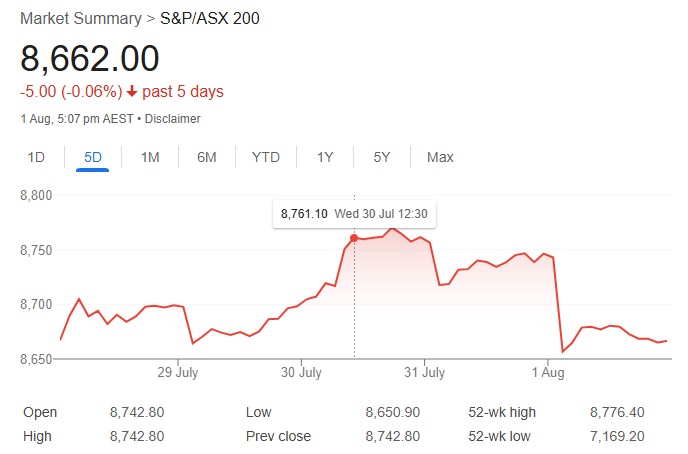| Name | Daily Close | Daily Change | Daily Change (%) |
|---|---|---|---|
| Dow | 44,173.64 | 585.06 | 1.34% |
| S&P 500 | 6,329.94 | 91.93 | 1.47% |
| Nasdaq | 21,053.58 | 403.45 | 1.95% |
| VIX | 17.52 | -2.86 | -14.03% |
| Gold | 3,433.40 | 7 | 0.20% |
| Oil | 66.23 | -0.06 | -0.09% |
OVERVIEW OF THE US MARKET
A renewed wave of dip buying lifted stocks, with investors sifting through solid earnings amid bets the Federal Reserve will soon cut rates. Bonds saw small moves ahead of a heavy slate of US debt sales.
The rebound in risk appetite drove the S&P 500 up 1.5%, its biggest rally since May. Almost every major group in the US equity benchmark advanced, and about 85% of its companies closed higher. Tech megacaps, which bore the brunt of the recent selling, led gains on Monday. Nvidia Corp. and Meta Platforms Inc. climbed at least 3.5%. The Russell 2000 index of small firms added 2.1%.
Last Friday’s weak employment data has bolstered hopes for interest-rate cuts from the Federal Reserve later this year. In the wake of Friday’s jobs report, investors ramped up bets that central bankers will cut rates in September.
Investors will also parse earnings updates from companies including McDonald’s, Disney and Uber later this week. About two-thirds of S&P 500 companies had reported quarterly results as of Friday. Of them, over 80% reported better-than-expected earnings per share, according to FactSet.
On the tariff front, President Donald Trump said he would be “substantially raising” the tariff on Indian exports to the US over the Asian nation’s purchases of Russian oil, a move New Delhi slammed as unjustified in an escalating fight between the two major economies.
Meantime, the European Union is expecting Trump to announce executive actions this week to formalize the bloc’s lower tariffs for cars and grant exemptions from levies for some industrial goods such as aviation parts, according to people familiar with the matter.
Corporate America continues to be one of the largest buyers of US stocks, showing confidence in their businesses despite unsettling tariff headlines.
July announced buybacks totalled a record-setting $165.63 billion, according to data compiled by Birinyi. Year-to-date announced buybacks now stands at $926.1 billion, the data showed.
OVERVIEW OF THE AUSTRALIAN MARKET

The Australian equity market stabilized on August 4, 2025, after Friday’s global sell-off triggered by US tariff uncertainties and weak economic data. The S&P/ASX 200 (XJO) eked out a 1.7-point gain, or 0.02%, to close at 8,663.7, trading 0.38% above its session low but just 0.03% shy of its high. The broader S&P/ASX 300 (XKO) showed a near balance of sentiment, with advancers (135) nearly matching decliners (136). The All Ordinaries rose 0.06% to 8,922.0.
Friday’s US market rout, driven by a dismal non-farm payrolls report (73,000 jobs added vs. 110,000 expected, with downward revisions to May and June), a PCE Price Index miss (2.8% vs. 2.7% expected), and President Trump’s firing of the BLS commissioner, fuelled global risk-off sentiment. However, rising iron ore and gold prices provided a lifeline for Australian equities. The Materials sector (XJR, +1.22%) led gains, with BHP (+0.9%), Fortescue (+1.4%), and gold miners like Northern Star (+5.6%) and Vault Minerals (+7.4%) shining. Consumer Staples (+1.15%) also supported the index, with Endeavour Group (+3%) buoyed by corporate news of its executive chair’s departure.
Financials (-0.57%) and Energy (-0.57%) weighed on the index, with all big four banks declining, led by ANZ (-1.6%). Technology (XIJ, -0.42%) continued to slide, with WiseTech (-1.7%) hit by its $3.25 billion e2Open acquisition and Block (-4%) ahead of its earnings. Utilities (+0.58%) and Health Care (+0.17%) offered defensive support, though tariff fears lingered, particularly after Trump’s scattergun trade policies reignited de-dollarization concerns. The AUD/USD rose 0.18% to 0.6483, bolstered by commodity strength but tempered by a strong US dollar.
Investors are eyeing the RBA’s August 5 meeting, with expectations of a rate cut strengthened by the S&P Global Services PMI (54.1) and Composite PMI (53.8), signaling robust economic activity. However, global trade tensions and upcoming US data, including the ISM Non-Manufacturing PMI, could sway sentiment.

